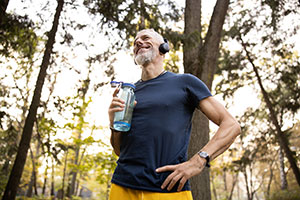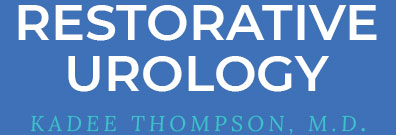Male Stress Incontinence
 Prostate Cancer is the most common cancer among men in the U.S. Fortunately, early diagnosis and effective treatment extends life for most men with prostate cancer. In many cases, however, sexual and bladder health concerns can persist after prostate cancer treatment and can create ongoing emotional, physical, and relational challenges. Research shows that education and support for sexual and urinary recovery has an impact on both quality of life AND cancer survival! To learn more about Dr. Thompson’s support of prostate cancer survivors, explore our Prostate Cancer Recovery Page or sexual wellness treatments.
Prostate Cancer is the most common cancer among men in the U.S. Fortunately, early diagnosis and effective treatment extends life for most men with prostate cancer. In many cases, however, sexual and bladder health concerns can persist after prostate cancer treatment and can create ongoing emotional, physical, and relational challenges. Research shows that education and support for sexual and urinary recovery has an impact on both quality of life AND cancer survival! To learn more about Dr. Thompson’s support of prostate cancer survivors, explore our Prostate Cancer Recovery Page or sexual wellness treatments.
Prostate treatment side effects may include male incontinence or urinary leakage. Here at Restorative-Urology, we champion both longevity and wellness. We strive to provide treatment options that allow men to recovery urinary function after prostate treatments.
What is Incontinence?
Urinary incontinence occurs when urination occurs outside of your control. All prostate cancer treatments, including radiation, cryotherapy, and surgery, may disrupt bladder or pelvic muscle function and nerve signaling, thereby causing problems with urinary control. The amount of leakage can vary, resulting in mild (only minor spotting), moderate, or severe incontinence, requiring multiple diaper changes daily. Treatment options will depend on type and severity of leakage. Many men with urinary incontinence suffer embarrassment from their condition and do not know that there are treatments that can help. If your urinary control impacts your confidence and freedom, we can help you pursue successful treatment.
Stress Incontinence
Stress incontinence (SUI) is leakage that is associated with physical activity such as coughing, sneezing, or heavy lifting. The most common cause of SUI in men is prostatectomy surgery, the removal of the prostate for cancer. While many men regain normal bladder control 1-2 years after recovery, 10% of men continue to experience bothersome urinary leakage one year after surgery. Some men will also experience urinary leakage with sexual arousal or orgasm. Coping options for SUI include absorbent products, condom catheters, or penile clamps. In the first 12-24 months after surgery, pelvic floor exercises can significantly improve urinary function. For those who do not regain urinary control, surgical options can help patients return to confidence and normalcy.
Here at Restorative-Urology, Dr. Thompson provides successful treatments such as the male sling and the artificial urinary sphincter to patients with persistent SUI. The Male Sling is a small sling made of soft mesh that is placed under the urethra to provide support to the urethral muscles. The sling effectively compresses the urethra and helps to block excess urinary leakage. While the success is highest in men with lower volume incontinence, the Male Sling enables many patients to recover urinary control immediately and 89% of patients report they are cured or improved.
For men that have high volume urinary incontinence, the artificial urinary sphincter (AUS) remains the gold standard treatment for SUI after prostate surgery. The sphincter is a saline-filled cuff that holds the urethra closed until a pump in the scrotum is cycled to enable urination. The AUS mimics a normal, healthy urinary sphincter and provides continence to many patients suffering from SUI. Because it provides reliable urinary control, 90% of patients report satisfaction with their AUS procedure.
For more information, to take a urinary assessment quiz and explore www.fixincontinence.com to learn more about urinary recovery.
Urge Incontinence or Overactive Bladder
Urinary incontinence (also known as overactive bladder (OAB)) occurs when a man develops significant urgency that may result in urinary leakage if he cannot make it to the bathroom. Some patients with OAB also experience significant urinary frequency, urgency, or nighttime urination. OAB may occur after various types of radiation for prostate cancer or may be a result of damage to the bladder from enlarged prostate, neurologic disease, diabetes, or stroke. As many as 30% of men live with OAB symptoms in the U.S., and OAB significantly impacts work, social life, and sleep. In some cases, lifestyle changes such as limiting caffeine and fluids, double voiding, and timed urination can improve OAB symptoms. Pelvic exercises in the form of bladder re-training or biofeedback may improve some mild OAB symptoms. Patients are often offered medication as initial treatment for OAB. Two classes of oral medications can improve bladder capacity and unwanted bladder contractions. While these medications work for some patients, side effects or cost may limit usefulness. For patients who suffer ongoing OAB symptoms, we can offer more advanced treatments to offer hope and restoration.
